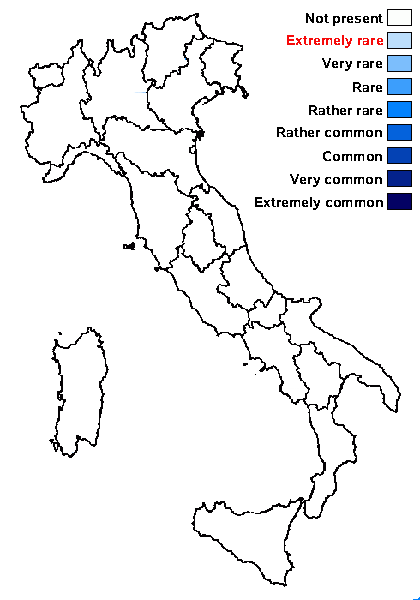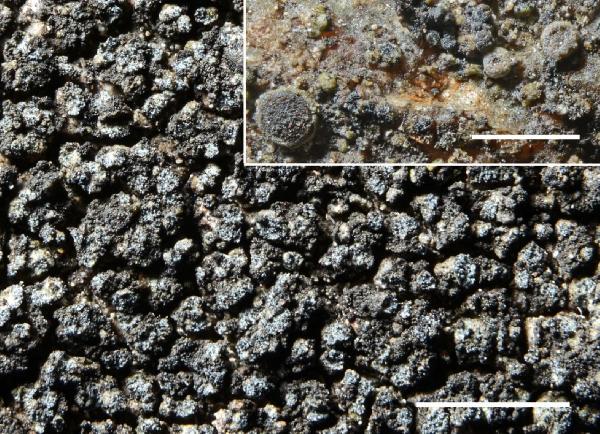Halecania pannarica M. Brand & van den Boom
in van den Boom, Bryologist, 112, 4: 830, 2009.
Synonyms:
Distribution:
Description: Thallus crustose-areolate to subsquamulose, episubstratic, sorediate/blastidiate, pale grey to grey-brown, dull, the areoles/squamules flat, ecorticate, 0.3-1.3 mm wide and to 0.17 mm thick, the largest ones often lobulate; soralia laminal, maculiform, 0.1-0.3 mm across, at first weakly crateriform then flat, bluish black, bearing dark gray to black, c. 22 µm wide soredia/blastidia, the algae enclosed in a brownish to bluish green outer layer of hyphae. Apothecia rare, lecanorine, 0.2-0.6 mm across, at first semi-immersed, then adnate, with a brown to black disc and a usually persistent, smooth thalline margin. Exciple brownish in upper and outer part, colourless within; epithecium brown, N-, hymenium colourless, c. 60 µm high; paraphyses not or slightly coherent, the apical cells to 5(-6) µm wide, dark-capped. Asci 8-spored, narrowly clavate, with a blue outer coat and uniformly K/I+ blue apical dome, Catillaria-type. Ascospores 1-septate, not or only slightly constricted at septum, hyaline, (9-)10-14(-18) x 4.5-5.5(-6.5) µm, with a distinct, up to 1.5 µm thick gelatinous perispore at least when young. Pycnidia immersed to semi-immersed, c. 70 µm in diam. the conidiogenous cells pyriform, ca. 5 x 2.5 µm. Conidia ellipsoid, 2.2-2.8 x 1-1.2 µm. Photobiont chlorococcoid. Spot tests: K-, C-, KC-, P+ orange-red (reaction best observed on acetone extract). Chemistry: thallus with pannarin.Note: a species described from Switzerland and also known from France and Scandinavia, usually starting the life-cycle on different crustose silicicolous lichens, mostly in humid situations such as along creeks and streams in upland areas. The species, which contains pannarin and not pannaric acid as stated in the original description (see Westberg & al. 2023), is closely related to H. giraltiae, mainly differing in the presence of pannarin instead of argopsin. To be looked for in the Italian Alps.
Growth form: Crustose
Substrata: rocks
Photobiont: green algae other than Trentepohlia
Reproductive strategy: mainly asexual, by soredia, or soredia-like structures (e.g. blastidia)
paras crustose lichens

Predictive model
Growth form: Crustose
Substrata: rocks
Photobiont: green algae other than Trentepohlia
Reproductive strategy: mainly asexual, by soredia, or soredia-like structures (e.g. blastidia)
paras crustose lichens

Predictive model


